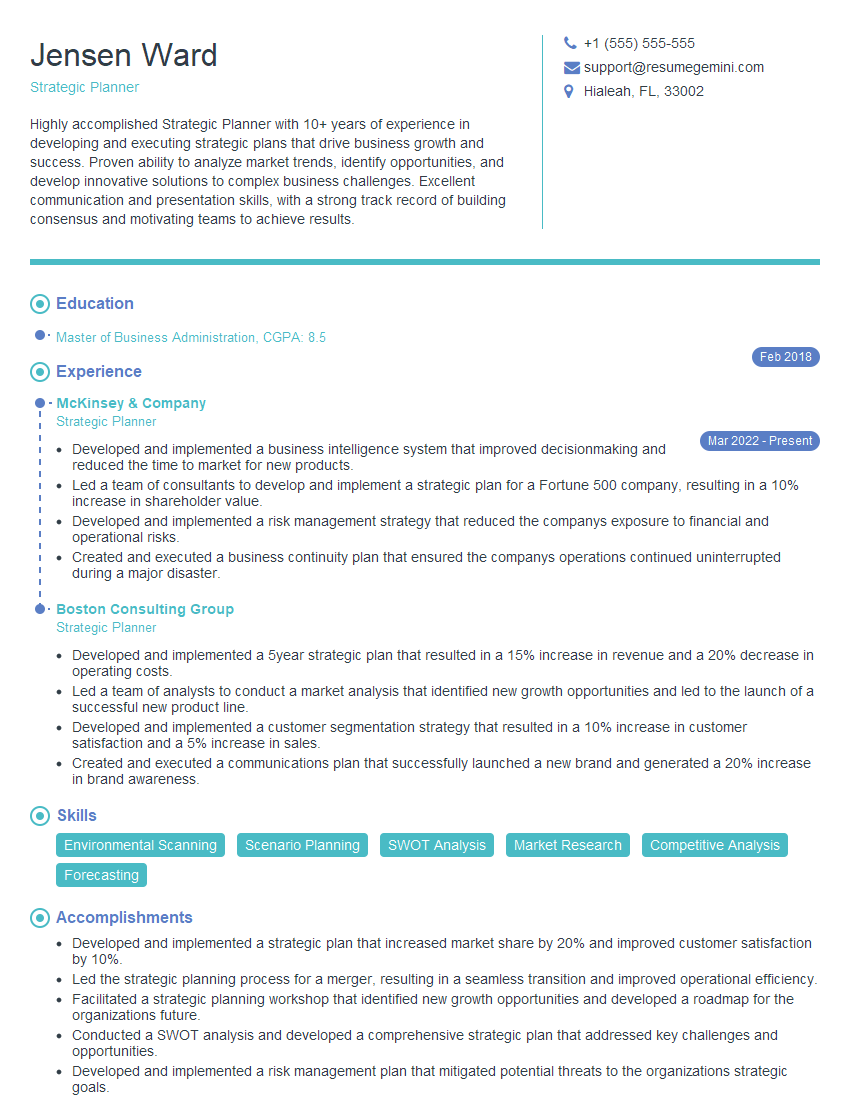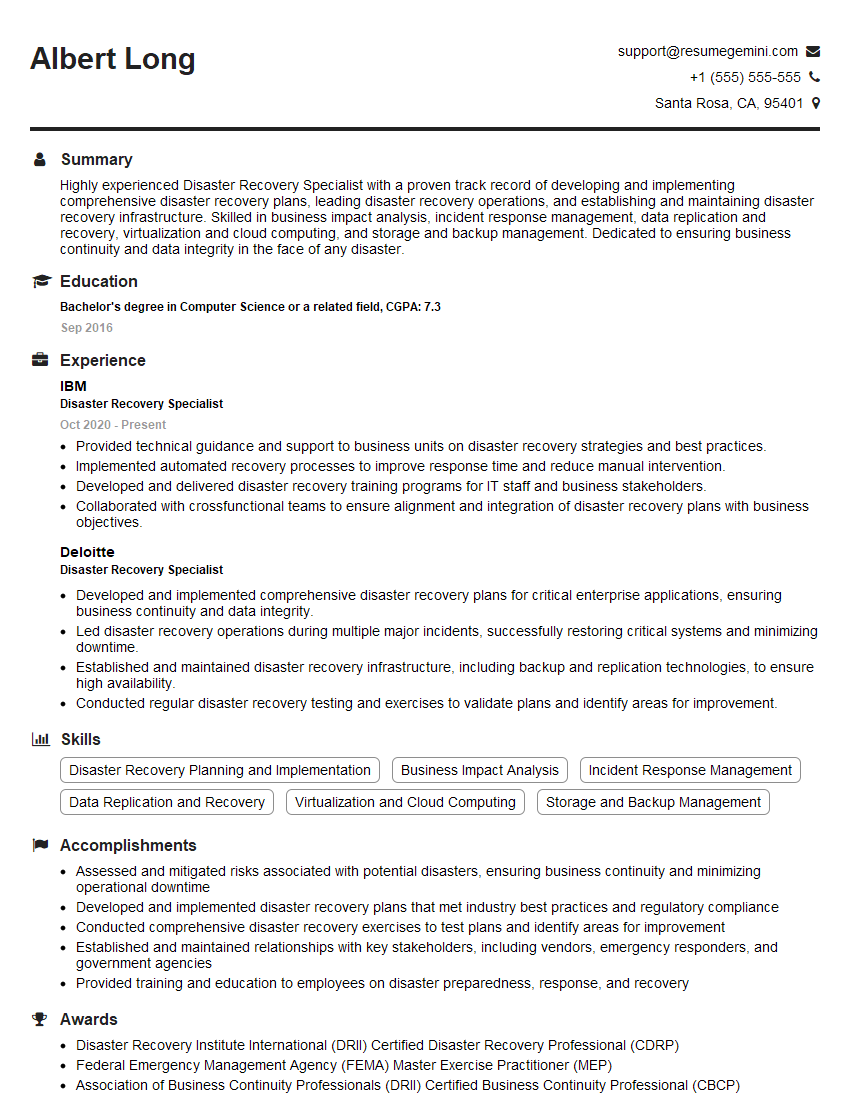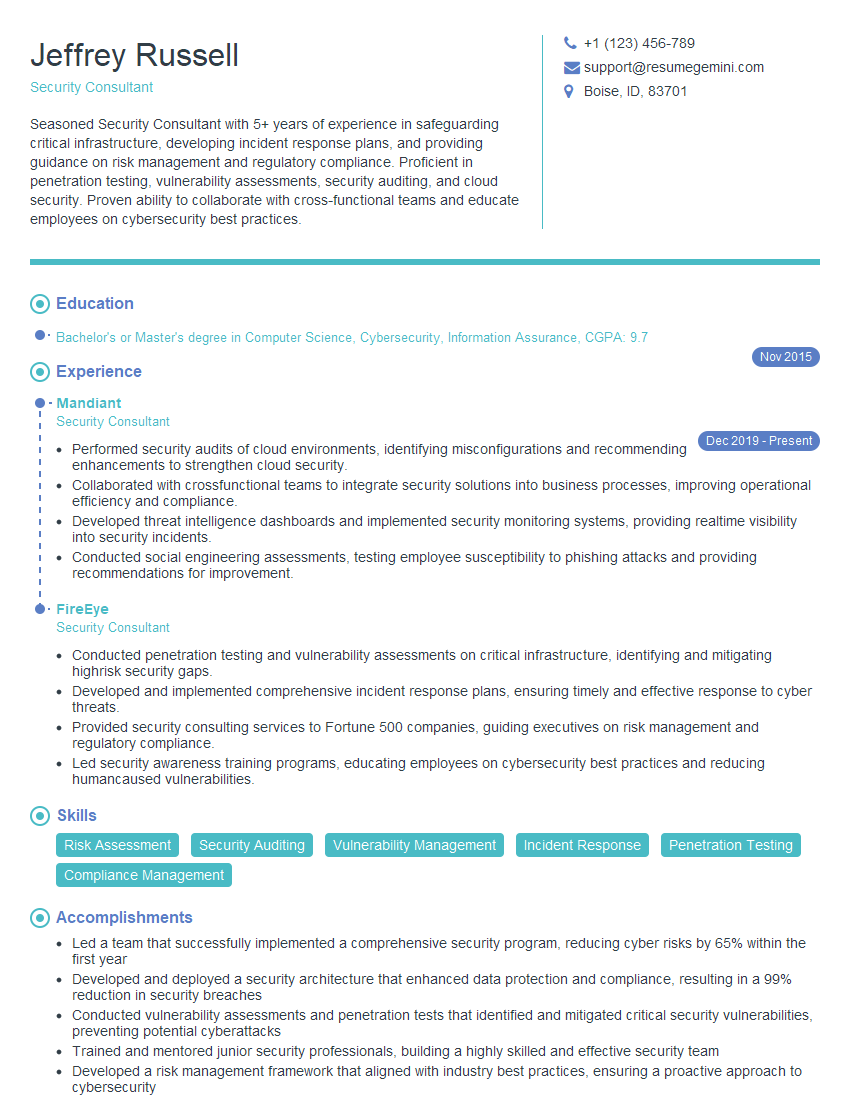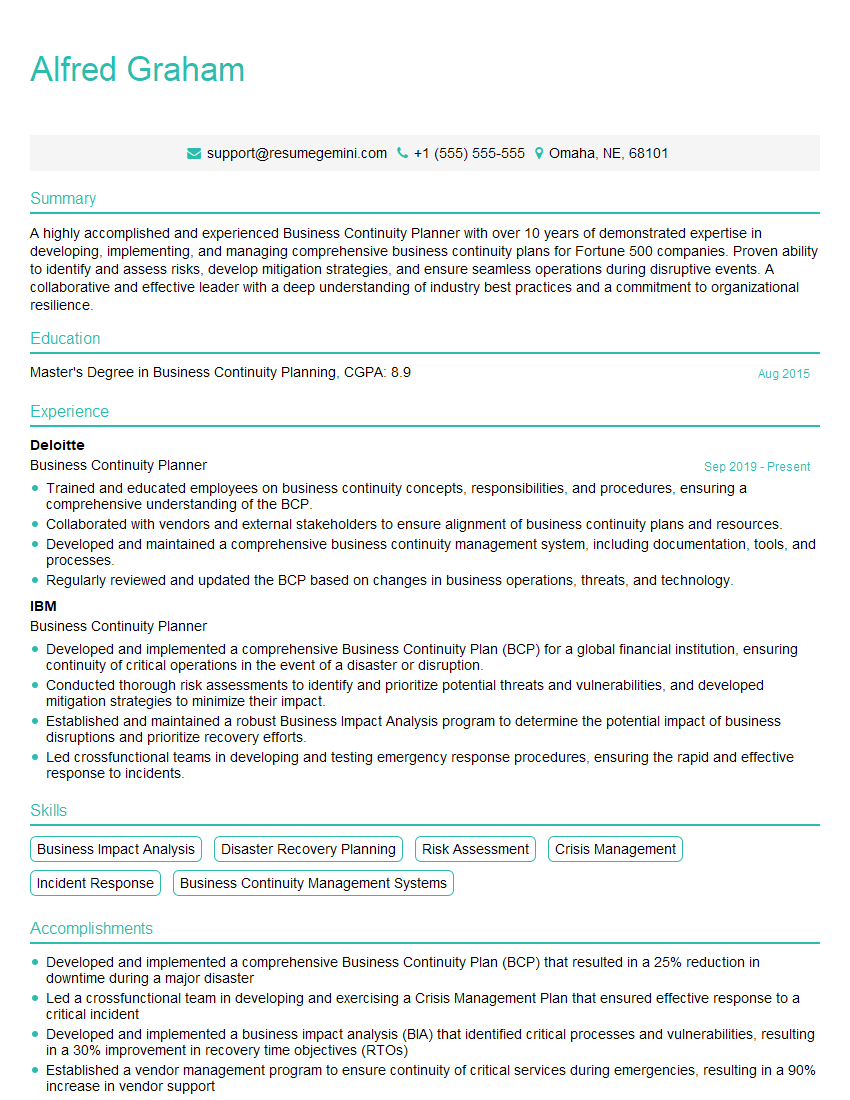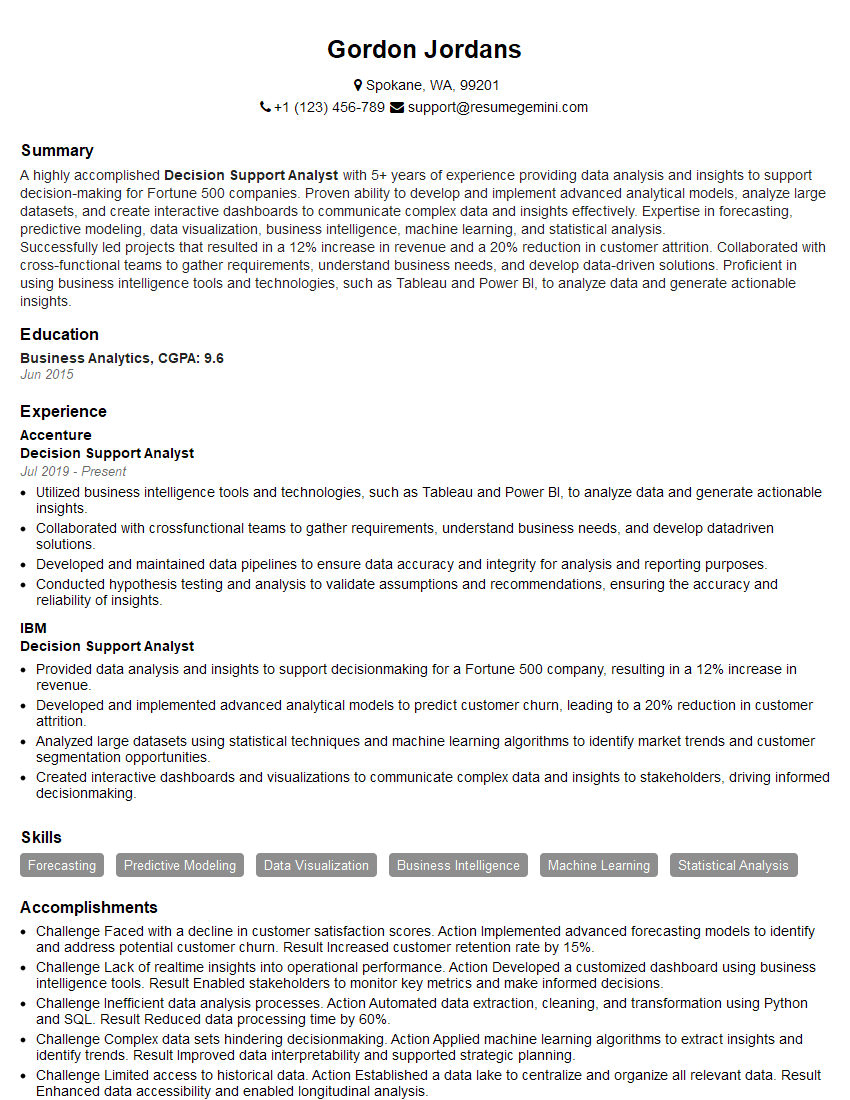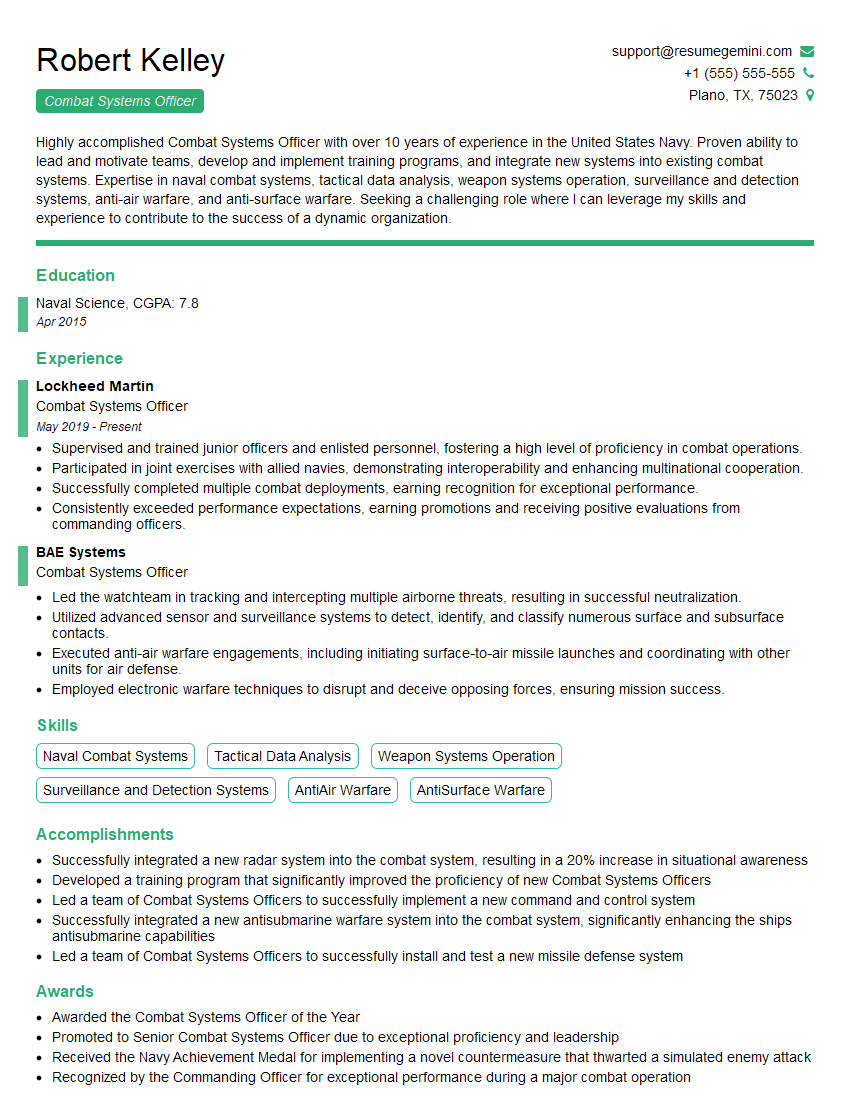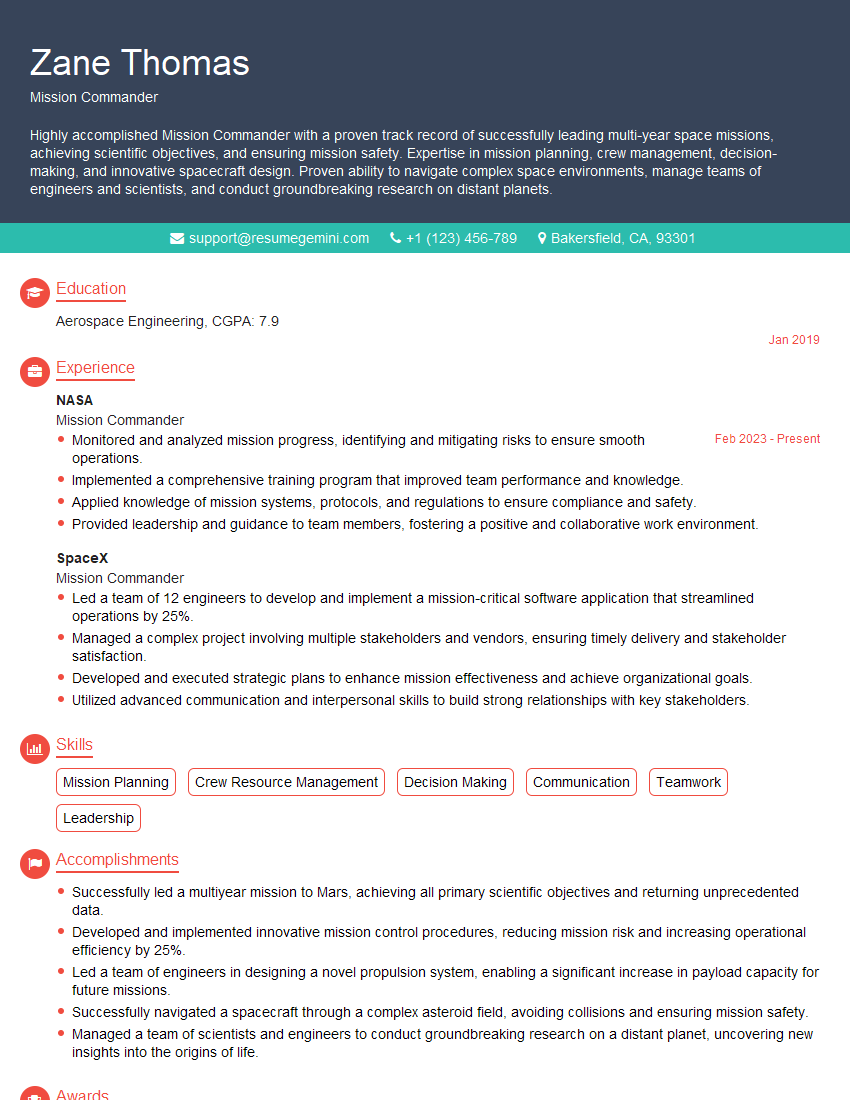Unlock your full potential by mastering the most common Tomahawk Tactical Decision Making interview questions. This blog offers a deep dive into the critical topics, ensuring you’re not only prepared to answer but to excel. With these insights, you’ll approach your interview with clarity and confidence.
Questions Asked in Tomahawk Tactical Decision Making Interview
Q 1. Describe the core principles of Tomahawk Tactical Decision Making.
Tomahawk Tactical Decision Making is a framework designed for rapid, effective decision-making under pressure. Its core principles revolve around prioritizing speed and decisiveness while mitigating risk. This is achieved through a structured process emphasizing:
- Situational Awareness: A clear understanding of the current environment and its potential impact.
- Risk Assessment: A rapid evaluation of potential threats and benefits.
- Decisive Action: Taking immediate action based on the assessment, accepting calculated risks when necessary.
- Continuous Monitoring & Adjustment: Regularly evaluating the effectiveness of decisions and adapting as the situation evolves.
Essentially, Tomahawk prioritizes action over prolonged analysis, recognizing that in dynamic environments, time is often a critical factor.
Q 2. Explain the importance of situational awareness in Tomahawk decision-making.
Situational awareness is paramount in Tomahawk. It’s the foundation upon which all subsequent decisions are built. Without a clear picture of the environment – including friendly forces, enemy capabilities, terrain, and weather – any risk assessment or decisive action is likely to be flawed. Consider a military commander planning an attack: accurate situational awareness includes understanding enemy troop strength, positioning, and likely responses. Lack of awareness could lead to an attack against a heavily fortified position, resulting in significant losses.
Maintaining situational awareness in Tomahawk involves active information gathering, continuous monitoring, and effective communication within the team. It requires a constant scan for changes and unexpected developments.
Q 3. How does risk assessment influence Tomahawk tactical choices?
Risk assessment is an integral part of Tomahawk, informing the choice of decisive action. It’s not about eliminating all risk, which is often impossible, but about evaluating the potential benefits and consequences of different options and selecting the course of action that best balances risk and reward. This evaluation needs to be quick and intuitive.
For example, a SWAT team deciding to breach a door needs to weigh the risk of injuring innocent bystanders against the urgency of apprehending the suspect. A high probability of success with a low risk of collateral damage would favor immediate action; conversely, a high probability of collateral damage would call for a more cautious approach, potentially involving further surveillance and alternative tactics.
Q 4. What are the key limitations of the Tomahawk decision-making framework?
While effective in many situations, Tomahawk has limitations. Its emphasis on speed can lead to:
- Oversimplification: Complex scenarios might be reduced to overly simplistic assessments, potentially overlooking crucial details.
- Bias & Error: Under pressure, decision-makers can fall prey to cognitive biases, leading to poor judgments.
- Lack of Planning: The focus on immediate action may lead to insufficient planning for contingencies.
- Inadequate Information: Rushing into action can occur before sufficient information is gathered.
The effectiveness of Tomahawk relies heavily on the experience and training of the decision-maker. In situations demanding thorough analysis and planning, a more deliberate approach might be necessary.
Q 5. Explain the concept of ‘decisive action’ within the Tomahawk model.
Decisive action is the heart of Tomahawk. It’s about taking swift, informed action based on the available information and risk assessment. It’s not necessarily about the ‘best’ option, but the most appropriate option given the time constraints and circumstances. It involves making a choice and acting on it without undue delay.
Imagine firefighters battling a blaze: decisive action might involve immediately deploying a hose to a critical area, even if detailed information about the fire’s spread is incomplete. The cost of delay could be catastrophic. While a thorough plan is ideal, decisive action prioritizes immediate action to improve the overall outcome.
Q 6. How does the Tomahawk model address time constraints in decision-making?
Tomahawk is explicitly designed to address time constraints. Its structure prioritizes speed and efficiency. It achieves this through:
- Simplified Processes: The decision-making process is streamlined to avoid unnecessary steps.
- Mental Rehearsal: Training and practice are crucial to develop the ability to make quick, effective decisions under pressure.
- Pre-planned Options: Having pre-determined courses of action for common scenarios allows for faster response times.
- Clear Communication: Efficient communication ensures that everyone understands the situation and the chosen course of action.
By minimizing unnecessary analysis and emphasizing preparedness, Tomahawk helps decision-makers act decisively within tight timeframes.
Q 7. Describe a situation where you had to make a rapid, high-stakes decision.
During a complex cybersecurity incident, our team detected a large-scale Distributed Denial of Service (DDoS) attack targeting our critical infrastructure. We had only minutes to respond before significant disruption to services occurred. Using Tomahawk principles, we rapidly assessed the situation, identifying the attack vector and its potential impact. We bypassed detailed analysis of the origin and immediately implemented mitigation strategies based on pre-defined protocols, such as prioritizing traffic and rerouting through redundant servers.
This rapid, decisive action minimized the impact of the DDoS attack, resulting in significantly less service disruption than initially feared. It highlighted the importance of effective pre-planning and rapid decision-making in time-critical events.
Q 8. How did you utilize available resources to inform your decision?
Informing my decisions using available resources hinges on a structured approach. It starts with identifying all relevant resources – this could range from real-time data feeds and intelligence reports to the expertise of my team members. I then prioritize these resources based on their reliability and relevance to the specific problem. For example, in a complex operational situation, I might prioritize verified intelligence over anecdotal evidence. Once prioritized, I meticulously analyze the information, looking for patterns, inconsistencies, and potential biases. I utilize tools like SWOT analysis (Strengths, Weaknesses, Opportunities, Threats) to synthesize this information into a clear, actionable picture. Finally, I document the entire process, ensuring transparency and accountability.
For instance, during a past operation, we had limited satellite imagery but access to excellent human intelligence (HUMINT) from local informants. I weighted the HUMINT more heavily after cross-referencing it with available technological data to confirm its credibility, thereby significantly shaping our tactical plan.
Q 9. How did you mitigate risks in that high-stakes situation?
Risk mitigation in high-stakes situations demands proactive planning and flexible execution. The Tomahawk model emphasizes anticipating potential problems – thinking ahead to what could go wrong. This involves conducting thorough risk assessments, identifying potential threats, and developing contingency plans. We use a layered approach to risk mitigation. First, we eliminate as many risks as possible – for example, avoiding known dangerous routes. Then we mitigate remaining risks by employing safety protocols and redundancy. Finally, we accept certain low-probability, low-impact risks, documenting them and understanding the trade-offs involved.
In one instance, we faced the potential for ambush during a nighttime operation. To mitigate this, we used advanced surveillance techniques to scan the area, deployed multiple observation posts, and maintained strict radio silence to minimize our signature. Our layered approach proved successful; we avoided the ambush and completed the mission safely.
Q 10. What was the outcome of your decision, and what did you learn?
The outcome of my decisions is always evaluated post-mission through a thorough after-action review (AAR). This process allows us to analyze what worked, what didn’t, and why. Learning is central to the process; we dissect the successes and failures objectively, identifying areas for improvement in our decision-making process, our training, and our equipment. We often discover that even seemingly successful outcomes had elements that could have been improved. This iterative learning process is critical to refining our tactics and improving future outcomes. For instance, a successful operation might highlight a communication breakdown that, if addressed, could lead to even better coordination in the future.
One particularly impactful learning experience involved a mission where initial intelligence was flawed. Though we succeeded, the AAR highlighted the need for better information validation, leading to improved training and procedural changes that now ensure more rigorous intelligence vetting.
Q 11. Explain how you would apply the Tomahawk model to a specific scenario (e.g., a cybersecurity incident).
Applying the Tomahawk model to a cybersecurity incident involves a structured, systematic approach. First, we define the problem – the nature and scope of the breach. Then we gather information – logs, alerts, and network data – and assess the situation. This assessment uses the Tomahawk framework to analyze the threat, the vulnerabilities, and our capabilities to respond. We prioritize actions based on impact and urgency, focusing on containment and remediation. Contingency plans address potential escalations or failures. Throughout the process, communication is paramount. Finally, we document everything, providing a record for future analysis and improvement.
For example, if a ransomware attack occurs, we’d first contain the spread by isolating affected systems. Then, we’d prioritize data recovery, determine the source of the attack, and implement enhanced security measures to prevent future breaches. The post-incident AAR would focus on identifying vulnerabilities in our network defenses and improving our response procedures.
Q 12. How do you balance speed and accuracy in tactical decision-making?
Balancing speed and accuracy in tactical decision-making is a constant challenge. The Tomahawk model helps by providing a framework for rapid but informed decisions. Speed is crucial in time-sensitive situations, but rushing leads to errors. Accuracy ensures the best possible outcome. The key is to use efficient analysis techniques and prioritize information. We use heuristics (mental shortcuts) when necessary, but always check them against available data. Practice and training are vital in developing this balance – muscle memory and structured analysis enable rapid, informed responses.
Imagine a scenario where you need to react to an incoming threat. Quickly assess the situation, prioritizing the most important information. Make a rapid decision based on your training and experience, but maintain flexibility to adapt as new information emerges.
Q 13. How do you handle conflicting information when making tactical decisions?
Handling conflicting information requires a critical and analytical mindset. It starts with identifying the sources of the conflicting information and assessing their credibility. This often involves verifying information through multiple independent sources. If inconsistencies persist, we carefully weigh the evidence, considering the potential biases and limitations of each source. We might use techniques like Bayesian reasoning to update our beliefs in the face of new, conflicting evidence. The goal is not to eliminate all uncertainty, but rather to make the best decision possible given the available, sometimes contradictory information.
A situation involving contradictory intelligence reports, for example, might require consulting multiple experts and verifying the reports with ground truth observations before forming a coherent understanding and making a tactical decision.
Q 14. How do you ensure effective communication during a crisis?
Effective communication during a crisis requires clear, concise, and consistent messaging. We use pre-established communication protocols and channels to ensure that information flows seamlessly between team members and stakeholders. This includes regular updates, clear role assignments, and designated points of contact. Transparency is key; everyone needs to understand the situation and their role in resolving it. We avoid jargon and use plain language to ensure everyone understands the information. Active listening and feedback mechanisms are essential to ensure that everyone is on the same page. Regular briefings, both formal and informal, are critical for maintaining situational awareness and coordinating actions.
During a large-scale incident, for example, we’d establish a central command post with clear communication lines to field teams, support staff, and external stakeholders. Regular updates would be disseminated through pre-agreed channels, and a designated spokesperson would manage external communications.
Q 15. Describe your process for prioritizing tasks during a high-pressure situation.
Prioritizing tasks under pressure relies heavily on the Tomahawk model’s emphasis on speed, decisiveness, and adaptability. My process involves a rapid assessment using the ‘Observe, Orient, Decide, Act’ (OODA) loop, a core component of Tomahawk. I start by quickly identifying the most critical threats or objectives (Observe). Then, I rapidly analyze the situation, considering available resources, potential consequences, and timelines (Orient). This orientation phase involves filtering out noise and focusing on essential information. I weigh the urgency and impact of each task, prioritizing those that directly impact mission success or mitigate immediate threats. The weighting often uses a simple rubric: high impact/high urgency, high impact/low urgency, low impact/high urgency, low impact/low urgency. High impact/high urgency tasks always take precedence. Then, I develop a concise plan of action (Decide) which might include breaking down complex tasks into smaller, manageable chunks. Finally, I execute the plan, taking decisive action (Act). I constantly monitor progress and adapt as needed, returning to the Observe phase if new information alters the priorities. For example, if during a hostage situation, while securing the perimeter (high impact/high urgency), a critical injury to a hostage occurs (shifting to high impact/high urgency), all efforts would immediately shift to medical attention.
Career Expert Tips:
- Ace those interviews! Prepare effectively by reviewing the Top 50 Most Common Interview Questions on ResumeGemini.
- Navigate your job search with confidence! Explore a wide range of Career Tips on ResumeGemini. Learn about common challenges and recommendations to overcome them.
- Craft the perfect resume! Master the Art of Resume Writing with ResumeGemini’s guide. Showcase your unique qualifications and achievements effectively.
- Don’t miss out on holiday savings! Build your dream resume with ResumeGemini’s ATS optimized templates.
Q 16. How do you manage stress and maintain focus under pressure?
Managing stress and maintaining focus under pressure is crucial for effective decision-making. The Tomahawk model helps by providing a structured approach that mitigates the chaos. I utilize several techniques. Firstly, deep, controlled breathing helps regulate my physiological response to stress. Secondly, mental rehearsal, imagining successful completion of tasks, builds confidence and reduces anxiety. I also rely on physical fitness and mental conditioning; regular exercise and mindfulness practices enhance resilience. Importantly, I remain focused on the immediate task at hand, avoiding distractions and unnecessary information overload. I consciously avoid dwelling on past mistakes or worrying about future uncertainties, keeping a sharp focus on the current priority. Finally, self-talk, positive reinforcement of my capabilities, keeps me motivated and in control. Think of it like a tightrope walker, maintaining balance and focus to avoid falling – stress is the wind, and my techniques are the tools to keep my balance.
Q 17. How do you adapt your decision-making approach based on changing circumstances?
Adaptability is a cornerstone of the Tomahawk model. My decision-making adapts based on feedback and changing circumstances through continuous monitoring of the situation. If unexpected events occur or new information emerges, I return to the ‘Orient’ phase of the OODA loop. I re-evaluate my assumptions, gather new data, and adjust my plan accordingly. This might involve adjusting priorities, allocating resources differently, or even abandoning a previous plan altogether. A flexible and agile approach is key. Imagine navigating a dense forest: a predetermined path might be disrupted by a fallen tree (unexpected event). Instead of stubbornly trying to follow the original plan, the effective navigator will assess the situation (re-orient), find a new path (re-decide), and continue towards the goal (re-act).
Q 18. How do you delegate responsibilities effectively in a tactical environment?
Effective delegation in a tactical environment requires clear communication, trust, and assigning tasks based on individual strengths and capabilities. Before delegating, I ensure my team members clearly understand the objective, the constraints (time, resources), and their specific roles and responsibilities. I provide them with the necessary authority and resources to complete the task. I continuously monitor progress and provide support and feedback, but I avoid micromanagement. Delegation isn’t about offloading work, it’s about empowering the team and optimizing the use of available skills and time. For instance, I wouldn’t assign a sniper to a close-quarters combat role; instead, they might be best used for long-range support. Clear communication of their role is crucial to team success.
Q 19. How do you evaluate the effectiveness of your decisions after the fact?
Post-decision evaluation is critical for continuous improvement within the Tomahawk framework. After a mission or operation, I conduct a thorough review, employing a structured process. This involves gathering data on outcomes: Did we achieve the objectives? What unexpected challenges arose? What was our resource expenditure? This is often done through after-action reviews with team members. The process is not about placing blame, but about identifying what worked well, what didn’t, and what could be improved in future similar situations. This information feeds back into my decision-making process, refining my understanding of various approaches and their effectiveness under different circumstances. We analyze the decision-making process itself, not just the outcome, to learn from mistakes and improve our ability to apply the Tomahawk model more effectively.
Q 20. What are some common pitfalls to avoid when using the Tomahawk model?
Common pitfalls when using the Tomahawk model include: overconfidence—believing one’s initial assessment is always correct, leading to a failure to adapt; tunnel vision—focusing solely on one aspect of the situation, ignoring others which can be detrimental; analysis paralysis—overthinking a decision, delaying action until it’s too late; and poor communication—failing to effectively communicate plans and updates with the team. Avoiding these pitfalls involves being self-aware, consciously challenging your own assumptions, and actively seeking feedback from the team. Regular practice and training are essential to master the dynamic nature of the Tomahawk approach and internalize effective decision-making processes.
Q 21. How does the Tomahawk model account for ethical considerations?
Ethical considerations are paramount and are explicitly integrated into the decision-making process within the Tomahawk framework. The ‘Orient’ phase specifically should incorporate a moral compass. Before deciding on a course of action, I always weigh the potential consequences against established ethical guidelines, laws, and organizational values. This involves considering the potential harm to civilians, the proportionality of force used (if applicable), and the overall fairness of actions. A key element here is the explicit consideration of collateral damage, understanding the potential risks and prioritizing safety and well-being to minimize harm. A decision that maximizes mission success but violates ethical principles is ultimately a poor decision, undermining long-term effectiveness and trust. Ethical considerations form an integral part of the ‘Decide’ and ‘Act’ phases, ensuring actions remain aligned with principles.
Q 22. How do you integrate collaboration into your Tomahawk decision-making process?
Integrating collaboration into Tomahawk decision-making is crucial for its effectiveness. Tomahawk, at its core, emphasizes speed and decisiveness, but this doesn’t negate the need for input and diverse perspectives. I approach this by employing a structured collaborative process, not a free-for-all brainstorming session. This involves:
- Pre-decision briefings: I convene briefings with relevant stakeholders *before* the critical decision point, ensuring everyone understands the situation, constraints, and available options. This allows for informed input and the identification of potential blind spots.
- Designated roles: We establish clear roles within the decision-making process. This might include a ‘challenger’ who questions assumptions, a ‘facilitator’ to manage the discussion, and ‘subject matter experts’ contributing specialized knowledge.
- Structured communication channels: We utilize communication tools like secure messaging platforms or collaborative software to streamline information sharing and ensure everyone has access to the most up-to-date information, preventing misunderstandings and delays.
- Post-decision debrief: Following the decision, we conduct a thorough debrief to analyze the process, assess the outcome, and identify areas for improvement in future collaborative efforts. This fosters a culture of continuous learning and refinement.
For example, during a complex deployment scenario, I might use a pre-briefing to gather intelligence from various units, then utilize a secure platform to share risk assessments and potential responses, culminating in a collaborative decision on the optimal course of action.
Q 23. How do you handle uncertainty and incomplete information?
Uncertainty and incomplete information are inherent in tactical decision-making. My approach focuses on mitigating risks and making the best possible decision under the given circumstances. This involves:
- Scenario planning: We develop multiple plausible scenarios based on available intelligence, considering both best-case and worst-case outcomes. This allows us to adapt our strategies if the situation changes.
- Risk assessment: We systematically identify and assess potential risks associated with each scenario, quantifying them where possible. This allows prioritization and resource allocation to mitigate the most significant threats.
- Decision trees and matrices: These tools provide a visual representation of different options and their potential consequences, facilitating a more structured and analytical approach to decision-making under uncertainty.
- Continuous monitoring and adaptation: We continuously monitor the situation and collect new information, adjusting our approach as needed. Flexibility is key in handling evolving circumstances.
Imagine a search and rescue operation where the location of the missing person is uncertain. We’d develop scenarios based on potential locations, assess the risks of each search area (terrain, weather), and use a decision matrix to weigh the urgency against the risks to determine the optimal starting point for the search.
Q 24. Describe your experience using decision-support tools and technology.
I have extensive experience using various decision-support tools and technologies, including:
- Geographic Information Systems (GIS): For visualizing terrain, identifying routes, and analyzing logistical aspects of operations.
- Simulation software: To model various scenarios and predict outcomes, allowing for testing different strategies and identifying potential flaws.
- Data analytics platforms: To analyze large datasets of intelligence, logistics, and performance metrics to inform decision-making.
- Communication platforms: Secure messaging systems, video conferencing, and collaborative document editing tools to facilitate teamwork and efficient information sharing.
For instance, in a resource allocation scenario, I might use a data analytics platform to identify patterns in resource consumption, then utilize simulation software to model different resource allocation strategies and assess their efficiency before making a final decision.
Q 25. How do you ensure your decisions align with organizational objectives?
Aligning tactical decisions with organizational objectives requires a clear understanding of the overall strategic goals. I ensure this alignment by:
- Understanding the strategic plan: I proactively study and thoroughly understand the organization’s strategic plan, identifying key performance indicators (KPIs) and objectives relevant to my area of responsibility.
- Prioritizing objectives: I prioritize tactical decisions that directly contribute to the achievement of strategic goals, ensuring that short-term gains don’t compromise long-term objectives.
- Regular review and adjustment: I regularly review tactical plans and decisions to ensure they remain aligned with evolving strategic priorities. Adaptability is vital in dynamic environments.
- Communication and collaboration: I maintain open communication with senior leadership to ensure alignment and gain feedback on tactical strategies.
For example, if the organization’s strategic goal is to enhance operational efficiency, my tactical decisions in resource allocation would focus on maximizing efficiency gains and minimizing waste.
Q 26. How do you measure the success of your tactical decisions?
Measuring the success of tactical decisions is crucial for continuous improvement. I utilize a multi-faceted approach:
- Pre-defined metrics: We establish clear, measurable metrics before implementing any tactical plan. These metrics are specific to the objectives and should be quantifiable (e.g., time saved, resources utilized, casualties avoided).
- Data collection and analysis: We collect data systematically throughout the implementation, using both quantitative and qualitative data sources.
- Post-action reviews: We conduct thorough post-action reviews, analyzing both the successes and failures to identify areas for improvement. This process includes comparing actual results against pre-defined metrics.
- Feedback mechanisms: We incorporate feedback from involved personnel and stakeholders to gain a comprehensive understanding of the effectiveness of the decision.
For instance, in a security operation, we might measure success by the number of threats neutralized, the level of collateral damage, and the time taken to complete the mission, comparing these to pre-defined targets.
Q 27. What are your strengths and weaknesses in tactical decision-making?
My strengths in tactical decision-making include:
- Analytical thinking: I can quickly assess complex situations and identify key factors.
- Adaptability: I remain flexible and adjust strategies as the situation evolves.
- Collaboration skills: I effectively integrate the input of diverse stakeholders into the decision-making process.
- Risk management: I proactively identify and mitigate potential risks.
However, a weakness could be a tendency towards over-analysis in high-pressure situations. I am actively working on improving my ability to act decisively when time is of the essence while still considering crucial factors.
Q 28. Describe a time you failed to make a good tactical decision. What did you learn?
In a past operation, I underestimated the adaptability of the opposing force. Based on prior intelligence, I assumed their response would follow a predictable pattern. However, they reacted unexpectedly, leading to a tactical setback. This failure highlighted the importance of:
- Contingency planning: Developing robust plans to address unexpected developments and contingencies is paramount.
- Information gathering: Continuous monitoring of the situation and proactive intelligence gathering are critical to minimize surprises.
- Flexibility and adaptability: Being willing to adapt strategies quickly, even if it means deviating from the original plan.
The experience taught me to avoid making assumptions based solely on past data and to embrace a more dynamic and adaptable approach to decision-making, constantly reevaluating information and adjusting plans accordingly. It also reinforced the need for more robust scenario planning.
Key Topics to Learn for Tomahawk Tactical Decision Making Interview
- Understanding the Tomahawk Process: Familiarize yourself with the core principles and phases of the Tomahawk decision-making model. This includes understanding its iterative nature and the importance of feedback loops.
- Scenario Analysis & Risk Assessment: Practice applying the Tomahawk framework to various hypothetical scenarios. Focus on identifying potential risks, evaluating options, and mitigating negative consequences.
- Communication & Collaboration: Understand how effective communication and collaboration are integral to the Tomahawk process, particularly in team-based decision-making situations.
- Data-Driven Decision Making: Explore how data analysis and objective information contribute to sound decisions within the Tomahawk framework. Practice interpreting data to inform your choices.
- Decision Justification & Documentation: Learn how to clearly and concisely justify your decisions using the Tomahawk methodology. This includes documenting your reasoning and the evidence supporting your choices.
- Adaptability & Iteration: Master the iterative nature of the Tomahawk process. Understand how to adapt your approach based on new information and changing circumstances.
- Ethical Considerations: Explore the ethical implications of decisions made using the Tomahawk framework and how to ensure ethical considerations are integrated into the process.
Next Steps
Mastering Tomahawk Tactical Decision Making significantly enhances your problem-solving skills and strategic thinking, making you a highly valuable asset in any organization. This skill is increasingly sought after, significantly boosting your career prospects and opening doors to exciting opportunities.
To maximize your job search success, create an ATS-friendly resume that effectively showcases your Tomahawk Tactical Decision Making skills. ResumeGemini is a trusted resource that can help you build a professional, impactful resume. Using ResumeGemini, you can craft a resume that highlights your relevant experience and skills, maximizing your chances of getting noticed by recruiters. Examples of resumes tailored to Tomahawk Tactical Decision Making are available to guide you.
Explore more articles
Users Rating of Our Blogs
Share Your Experience
We value your feedback! Please rate our content and share your thoughts (optional).
What Readers Say About Our Blog
Hello,
We found issues with your domain’s email setup that may be sending your messages to spam or blocking them completely. InboxShield Mini shows you how to fix it in minutes — no tech skills required.
Scan your domain now for details: https://inboxshield-mini.com/
— Adam @ InboxShield Mini
Reply STOP to unsubscribe
Hi, are you owner of interviewgemini.com? What if I told you I could help you find extra time in your schedule, reconnect with leads you didn’t even realize you missed, and bring in more “I want to work with you” conversations, without increasing your ad spend or hiring a full-time employee?
All with a flexible, budget-friendly service that could easily pay for itself. Sounds good?
Would it be nice to jump on a quick 10-minute call so I can show you exactly how we make this work?
Best,
Hapei
Marketing Director
Hey, I know you’re the owner of interviewgemini.com. I’ll be quick.
Fundraising for your business is tough and time-consuming. We make it easier by guaranteeing two private investor meetings each month, for six months. No demos, no pitch events – just direct introductions to active investors matched to your startup.
If youR17;re raising, this could help you build real momentum. Want me to send more info?
Hi, I represent an SEO company that specialises in getting you AI citations and higher rankings on Google. I’d like to offer you a 100% free SEO audit for your website. Would you be interested?
Hi, I represent an SEO company that specialises in getting you AI citations and higher rankings on Google. I’d like to offer you a 100% free SEO audit for your website. Would you be interested?
good
